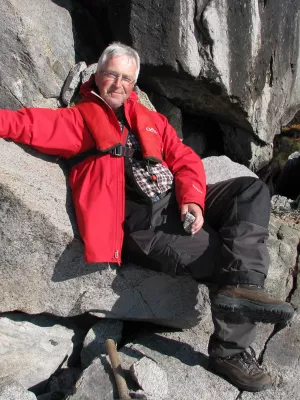
Leif Johansson
Professor emeritus

The Varberg-Torpa Charnockite-Granite Association, SW Sweden: Mineralogy, Petrology, and Fluid Inclusion Chemistry
Författare
Summary, in English
The Varberg-Torpa charnockite-granite association (Varberg, SW Sweden) consists of the magmatic Varberg charnockite (1399 +/- 6 Ma) and the Torpa granite (1380 +/- 12 Ma). The Torpa granite is both continuous and, based on its whole-rock geochemistry, synmagmatic with the Varberg charnockite. The granite body also contains a number of charnockite inliers. P-T estimation using garnet-clinopyroxene and orthopyroxene-clinopyroxene Fe-Mg exchange thermometry and garnet-orthopyroxene-plagioclase-quartz barometry gives temperatures and pressures (750-850 degrees C; 800-850 MPa) that most probably approximate the P-T conditions during emplacement of the charnockite compared with a lower crystallization temperature (650-700 degrees C) for the granite. The earliest recognized fluid inclusions in both the granite and charnockite consist of H2O-CO2 mixtures (H2O volume fraction 0 center dot 2-0 center dot 7). Fluid inclusions in the charnockite are characterized by high CO2 densities (up to 1 center dot 0 g cm(-3); 40-90% bulk CO2), of probable magmatic origin, and are best preserved in garnet, plagioclase, and fluorapatite (in order of decreasing CO2 densities), and sometimes also in clinopyroxene. Fluid inclusions with the highest CO2 densities (1 center dot 08-1 center dot 10 g cm(-3)) are found in quartz (T-h -31 to -36 degrees C) and may have originated under high P-T conditions during emplacement and cooling of the charnockite. Magmatic fluids in the granite correspond to aqueous-carbonic inclusions with an estimated bulk composition (mol %) of H2O 73%, CO2 25%, NaCl 2%. The salinity of the solutes in the granite (typically 14-20 wt % NaCl-eq.) is generally higher than for the charnockite (0-8 wt % NaCl-eq.). Field, petrographic, mineralogical, geochemical, and fluid inclusion evidence indicates that, compared with the H2O-rich granite, the magma responsible for the charnockite had a preponderance of CO2 over H2O, which lowered the H2O activity in the melt, stabilizing ortho- and clinopyroxene. This evidence also supports the idea that the granite and charnockite were derived from a common source magma (most probably a fluid-rich basalt at the base of the crust) as a result of fractional crystallization.
Avdelning/ar
- Berggrundsgeologi
Publiceringsår
2013
Språk
Engelska
Sidor
3-40
Publikation/Tidskrift/Serie
Journal of Petrology
Volym
54
Issue
1
Dokumenttyp
Artikel i tidskrift
Förlag
Oxford University Press
Ämne
- Geology
Nyckelord
- charnockite
- granite
- CO2
- brines
- fluid inclusions
- igneous petrology
- Varberg
- Torpa
- SW Sweden
Status
Published
ISBN/ISSN/Övrigt
- ISSN: 0022-3530

